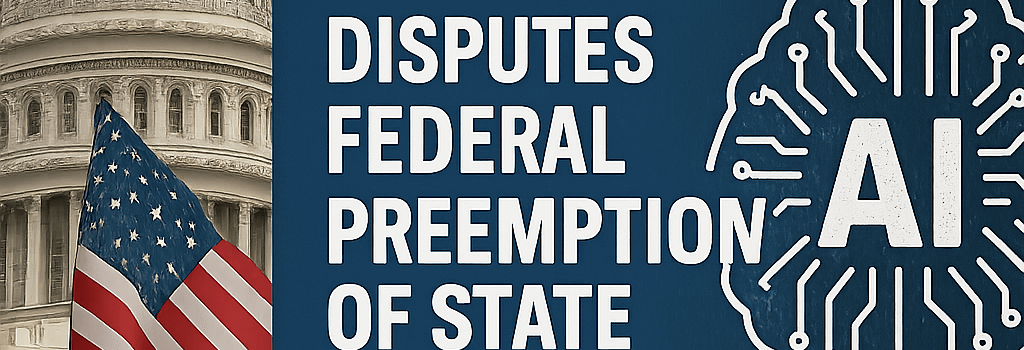Senate GOP Disputes Federal Preemption of State AI Laws

Background: Cruz’s AI Moratorium Proposal
On June 3, 2025, during a Senate Budget Committee hearing, Sen. Ted Cruz (R-Texas) unveiled a plan to impose a 10-year moratorium on all state-level artificial intelligence regulations by conditioning eligibility for federal broadband funds on non-regulation. Cruz’s approach would make any state that enacts AI safety, privacy, or liability laws ineligible for portions of the $42.45 billion Broadband Equity, Access, and Deployment (BEAD) program. Originally, his amendment sought an outright ban on state AI limits; after procedural concerns under the Senate’s Byrd Rule, it was revised to target a new $500 million “AI infrastructure” sub-grant within BEAD instead.
Understanding the Byrd Rule and Reconciliation
The Byrd Rule restricts Senate budget reconciliation bills from containing “extraneous matter.” Any senator can raise a point of order to strike such provisions, which can only be waived by a three-fifths (60-vote) majority. Cruz’s team argued that tying AI restrictions to a new appropriation for AI-capable network edge infrastructure—rather than the core broadband fund—insulates the provision from Byrd challenges. Senate Parliamentarian Elizabeth MacDonough confirmed that, in her view, the AI carve-out conforms to reconciliation criteria and is not extraneous.
Technical Implications for Broadband and AI Infrastructure
The BEAD program, funded by the Infrastructure Investment and Jobs Act, prioritizes fiber deployments capable of 100 Mbps symmetrical service. Cruz’s added $500 million would specifically subsidize:
- Installation of edge data centers within 25 miles of population centers, reducing round-trip latency for inference APIs to under 10 ms.
- Deployment of AI-optimized fiber runs supporting 400 Gbps Dense Wavelength Division Multiplexing (DWDM) links to regional hubs.
- Upgrading power and cooling systems at community anchor institutions to support racks of NVIDIA H100 or equivalent AI accelerators.
By conditioning states’ access to these grants on a ban of local AI regulation, the amendment could reshape how public broadband networks evolve to support high-performance computing (HPC) and on-premise AI deployments.
State-Level AI Regulations Under Threat
At least 24 states have enacted or proposed AI statutes in 2024–2025, addressing issues such as:
- Deepfake and synthetic media: Washington’s law prohibits unauthorized use of digital likenesses in political or non-consensual adult content.
- Automated decision systems: Illinois mandates biased AI audits and prohibits training models on face recognition data without consent.
- Consumer protection: California requires transparency disclosures when AI significantly influences commercial transactions.
A block on these laws via federal preemption raises concerns about leaving millions of Americans without recourse against AI-driven disinformation, algorithmic bias, and privacy violations.
Industry and Expert Reactions
Tech companies and AI safety advocates are divided. Lobby groups representing cloud providers AWS, Azure, and Google Cloud have signaled support for a uniform federal framework to avoid a patchwork of state rules, citing multi-million-dollar compliance burdens for distributed data centers running large language model (LLM) inference. Conversely, civil society organizations like the Electronic Frontier Foundation warn that deregulating at the state level could undercut consumer privacy and civil rights.
“A coherent national AI policy is needed, but not at the expense of innovation from states acting as ‘laboratories of democracy,’” said Dr. Rashida Patel, director of AI policy at the Center for Democracy & Technology.
Cloud Providers and Model Deployment
Major clouds are already rolling out AI-as-a-Service platforms with GPUs on demand (e.g., A100, H100, TPU v5). Uniform preemption could benefit hyperscalers by simplifying service agreements, but hamper edge AI startups that rely on state grants to build local compute nodes.
Legal and Policy Analysis
Legal scholars caution that blanket federal preemption via appropriations riders may face Commerce Clause and Nondelegation Doctrine challenges. By restricting fund eligibility rather than directly prohibiting state laws, Cruz’s amendment attempts a subtle form of commandeering, which the Supreme Court has historically frowned upon (New York v. United States, 1992; Printz v. United States, 1997).
Responses From Capitol Hill
Sen. Maria Cantwell (D-Wash.) and Sen. Marsha Blackburn (R-Tenn.) held a joint press conference denouncing the moratorium. Cantwell emphasized the risk to broadband expansion plans, while Blackburn—aligning with consumer protection proponents—argued that states must be free to enact emergent AI safeguards without fear of losing federally funded network upgrades.
Meanwhile, Sens. Ron Johnson (R-Wis.) and Josh Hawley (R-Mo.) have privately expressed concern that stripping state authority could backfire, prompting legal chaos and defunding of critical rural broadband projects.
Deeper Analysis: Impact on AI Safety Ecosystem
- Fragmentation vs. Uniformity: A single federal standard may streamline national data-sharing and model validation, but could stifle avant-garde local regulations—such as sandbox regimes or model-testing requirements.
- Incentives for Model Developers: Without state-level liability rules, companies might accelerate deployment of unvetted LLMs, raising the probability of harmful hallucinations or biased outcomes in high-stakes domains.
- Geopolitical Considerations: Analysts note that delaying robust AI legislation at any level could allow foreign adversaries to exploit U.S. legal gaps for disinformation campaigns or automated hacking tools.
Future Outlook and Next Steps
The Senate is scheduled to debate the reconciliation package on the floor in late July 2025. Striking the AI provision requires a simple majority vote. Observers anticipate additional amendments from both parties:
- Introducing a preemption sunset clause to revisit state authority after five years.
- Attaching an AI safety fund to support independent audits of large model deployments.
- Creating a bipartisan AI Council within the National Institute of Standards and Technology (NIST) to coordinate federal-state rulemaking.
Key takeaways: The outcome will shape whether the U.S. adopts a top-down approach to AI policy or allows states to continue pioneering diverse legal frameworks. With federal appropriations and model deployment pipelines at stake, this debate represents a critical inflection point in the governance of transformational AI technologies.